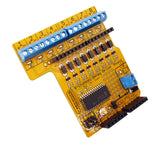In the last few months a variety of affordable electric remote-controlled helicopters have been released into the market, and some of them are controlled via infra-red. This gives you an opportunity to control them with infrared from another source - such as an Arduino! The process of doing this has been documented very well by Instructables user 'puzzlebox', who have written a tutorial on how to decode the IR signals from the factory controller and then add them to an Arduino sketch to allow it to take over control duties. It's clever and looks like a lot of fun.

Click here to find out how to do so, and for more, we're on twitter and Google+, so follow us for news and product updates as well.

When creating projects with external circuitry such as the infra-red transmitter - consider our range of ProtoShields. From the tiny LeoStick to the Mega range, we offer a complete range for you to work with.

























